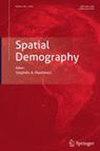地理编码水平对历史人口分析的重要性:1850-1914 年瑞典农村教区案例研究
IF 1.1
Q3 DEMOGRAPHY
引用次数: 0
摘要
通过对纵向和个人层面的历史人口数据库进行地理编码,可以对微观层面的地理因素如何影响长期的人口结果进行新颖的分析。然而,这种详细的地理编码涉及高昂的成本。此外,如果使用了不恰当的方法来量化地理因素,就无法正确利用高空间分辨率。我们评估了用于定义地理变量的不同地理编码水平和方法如何影响详细的空间和历史人口分析结果。我们使用一个纵向和个人层面的人口数据库,在财产单位层面进行地理编码,分析了 1850-1914 年间居住在瑞典五个教区的个人的人口密度和湿地邻近程度对全因死亡率的影响。我们比较了在三个详细地理编码级别上使用两种通用量化方法对每个地理变量进行分析的结果。连同所选的地理因素量化方法,财产单位和略微粗略的地理层次之间在定位精度上的微小差异(20-50 米)也会严重影响人口分析的结果。结果还显示了考虑地理随时间变化的重要性。最后,靠近湿地和人口密度分别影响了妇女和儿童的死亡率。不过,在分析中没有评估所有可能的死亡率决定因素。总之,对于历史上的农村地区来说,要对几百米内的距离进行精细分析,可能需要对财产单位进行地理编码。我们还必须仔细考虑最符合地理环境和分析类型的量化方法。本文章由计算机程序翻译,如有差异,请以英文原文为准。
Importance of the Geocoding Level for Historical Demographic Analyses: A Case Study of Rural Parishes in Sweden, 1850–1914
Geocoding longitudinal and individual-level historical demographic databases enables novel analyses of how micro-level geographic factors affected demographic outcomes over long periods. However, such detailed geocoding involves high costs. Additionally, the high spatial resolution cannot be properly utilized if inappropriate methods are used to quantify the geographic factors. We assess how different geocoding levels and methods used to define geographic variables affects the outcome of detailed spatial and historical demographic analyses. Using a longitudinal and individual-level demographic database geocoded at the property unit level, we analyse the effects of population density and proximity to wetlands on all-cause mortality for individuals who lived in five Swedish parishes, 1850–1914. We compare the results from analyses on three detailed geocoding levels using two common quantification methods for each geographic variable. Together with the method selected for quantifying the geographic factors, even small differences in positional accuracy (20–50 m) between the property units and slightly coarser geographic levels heavily affected the results of the demographic analyses. The results also show the importance of accounting for geographic changes over time. Finally, proximity to wetlands and population density affected the mortality of women and children, respectively. However, all possible determinants of mortality were not evaluated in the analyses. In conclusion, for rural historical areas, geocoding to property units is likely necessary for fine-scale analyses at distances within a few hundred metres. We must also carefully consider the quantification methods that are the most logical for the geographic context and the type of analyses.
求助全文
通过发布文献求助,成功后即可免费获取论文全文。
去求助
来源期刊

Spatial Demography
DEMOGRAPHY-
自引率
0.00%
发文量
12
期刊介绍:
Spatial Demography focuses on understanding the spatial and spatiotemporal dimension of demographic processes. More specifically, the journal is interested in submissions that include the innovative use and adoption of spatial concepts, geospatial data, spatial technologies, and spatial analytic methods that further our understanding of demographic and policy-related related questions. The journal publishes both substantive and methodological papers from across the discipline of demography and its related fields (including economics, geography, sociology, anthropology, environmental science) and in applications ranging from local to global scale. In addition to research articles the journal will consider for publication review essays, book reviews, and reports/reviews on data, software, and instructional resources.
 求助内容:
求助内容: 应助结果提醒方式:
应助结果提醒方式:


